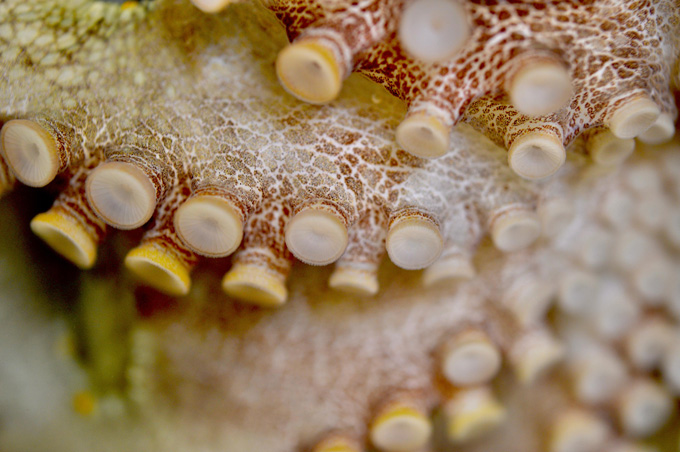This post was originally published on this site
People have different tastes. It turns out that octopuses, squid and cuttlefish do too.
These soft-bodied cephalopods have proteins on suckers along their tentacles that allow them to “taste” by touching objects. But the species have evolved to detect different compounds, researchers report in two studies published in the April 13 Nature. And the differing tastes may be tied to the species’ hunting styles.
All the species have modified versions of proteins called neurotransmitter receptors, which detect brain chemicals. Evolution morphed the brain proteins to take on new roles as taste-sensing proteins. But octopus evolution led them to develop a taste for greasy things, while squid and cuttlefish evolution tweaked the brain proteins to detect bitter compounds, the researchers discovered.
“This is an entirely new sensory system,” says Maude Baldwin, an evolutionary biologist at the Max Planck Institute for Biological Intelligence in Seewiesen, Germany, who was not involved in the work. “Together these papers offer unprecedented insight into how sensory systems evolve.”
Studying cephalopod receptors might also shed some light on how human taste-sensing proteins evolved. “It greatly enhances our understanding of how proteins evolve in general,” Baldwin says, as well as how proteins and even entire organisms acquire new functions.
Octopuses can taste many “greasy, sticky” molecules
In a previous study, Harvard physiologist Nicholas Bellono and colleagues discovered that barrel-shaped proteins known as chemotactile receptors in the suckers of California two-spot octopuses (Octopus bimaculoides) allow the animals to taste terpenes — “greasy,” insoluble molecules — with their arms (SN: 10/29/20).
To get a detailed look at these proteins, Bellono teamed up with structural biologist Ryan Hibbs of the University of Texas Southwestern Medical Center at Dallas. Hibbs and colleagues used cryoelectron microscopy to examine the three-dimensional structure of the protein.
When looking at the structure of the octopus protein, the researchers found an unexpectedly large molecule stuck in a special pocket used to detect certain chemicals. Finding a molecule stuck in one of these pockets can give clues to the protein’s function.

The mystery molecule turned out to be part of the detergent the researchers used to prepare the protein for the microscope. That’s very different from the types of molecules that bind to the neurotransmitter receptors from which chemotactile receptors evolved, says Hibbs, now at the University of California, San Diego. “Neurotransmitters are small and soluble. This thing is bulky and greasy.”
By testing a variety of molecules collected from neighboring labs, Bellono’s team determined that the octopus receptors can detect a variety of “greasy, sticky molecules” that don’t dissolve in water. Because octopuses feel around for their prey, it makes sense that their taste receptors evolved to detect molecules that remain stuck to underwater surfaces such as crab shells or their own eggs, rather than small chemicals that easily diffuse in water, Hibbs says.
But octopuses don’t seem to find all greasy molecules tasty. In one experiment, the researchers tested the response of a severed tentacle to one such chemical. The arm crawled off the measuring apparatus and right out of the bath.
Squid and cuttlefish can discern bitter compounds
To see if other cephalopods share octopuses’ tastes, the researchers turned to genetic analyses. Octopuses have 26 genes that each encode a slightly different chemotactile receptor protein. Those proteins can come together in combinations of five to detect a wide variety of molecules, the team found.
Examining genes from squid and cuttlefish, the researchers discovered that these cephalopod species also have modified neurotransmitter receptors in their suckers. But some of the squid and cuttlefish receptors detect bitter compounds which can diffuse in water, not the greasy ones octopuses taste. (Squid could also taste some terpenes, but not all of the greasy molecules octopuses detect.)
Bitter taste is often a signal that something is spoiled or poisonous, so animals usually avoid bitter compounds, says Harold Zakon, a neuroscientist and evolutionary biologist at the University of Texas at Austin who was not involved in the work.
Bitter compounds also caused squid to turn up their noses — or in this case, tentacles — at prey. Squid given shrimp soaked in a bitter compound handled the food longer before eating it than they did with undoctored prey. Or the squid rejected the bitter shrimp, something researchers never saw the animals do with regular prey.
The type of receptors the species have reflect their hunting strategies. Octopuses ”explore everything with their arms,” Bellono says, and likely use chemotactile receptors to guide their explorations. While octopuses use sight to catch prey out in the light of day, chemotactile receptors help them hunt in the dark and to find prey hidden in cracks and crevices, Bellono says. Squid and cuttlefish are ambush predators that rely on eyesight alone. The bitter receptors help squid decide whether to eat their prey only after they have it in their grasp.
The octopus and squid receptors evolved about 300 million years ago, early in the species’ histories. But it’s impossible to tell whether hunting style or receptor type came first or if the traits evolved together.
Octopuses also have another type of chemotactile receptor, the researchers found, but they don’t yet know what sorts of molecules those receptors sense.
It will take years to work out the details of what all the cephalopods’ receptors detect and how they influence animals’ behavior, Zakon says. “This is really a first announcement that these receptors have changed in fundamentally important ways.”
